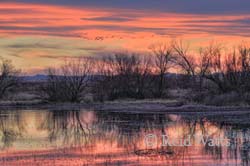Sandhill Cranes Facts and Their Winter Home
 The
Middle Rio Grande Valley of New Mexico is a major migration
route and the winter home for thousands of sandhill cranes. The
Middle Rio Grande Valley of New Mexico is a major migration
route and the winter home for thousands of sandhill cranes.
The quality of the winter habitat is critical since the
sandhills congregate in high densities and are dependent on
limited food resources.
The primary food source on which the sandhills feed is
waste corn.
The sandhills roost in shallow water each night where they seek
protection from their predators, especially coyotes.
Cranes seek isolated locations with minimal human
disturbance. The
ideal roost sites are within 10 miles of feeding sites.
During the day hundreds of sandhills can be seen in the
farmland fields of the river valley pecking away at cornfield
stubble.
Sandhill Cranes mate for life, and migrate south as a family
unit. Sandhill
cranes pairs usually raise only one young each year.
The breeding range of sandhills include
Alaska, Canada, western
Quebec, and northern and western United States, although
sandhills can be found as far north as Siberia.
There are resident population (non-migratory) sandhills
in southern Florida and Cuba. The life expectancy of a Sandhill
Crane is upwards of 30 years.
A crane fossil estimated to be 10 million years old, was found
in Nebraska. The
fossil matches the structure of the modern day sandhill crane
which makes the sandhill crane the oldest known bird species
still surviving.
About the Photographs:
"Wings of Fire" and "Sandhills of
Bernardo"
 The
“Wings of Fire” photograph was taken at the Bosque del Apache
National Wildlife Refuge in New Mexico, while “Sandhills of
Bernardo” was taken at the Bernardo Waterfowl Area just north of
Bosque del Apache.
Both wildlife areas feature shallow ponds created from diverted
water of the Rio Grande to create a waterfowl habitat ideal for
Sandhill Cranes as well as other migratory birds.
The staff at both areas cultivate hundreds of acres of
corn and grain crops to provide winter feed for the migratory
birds. The beautiful
landscape is completed by naturally occurring cottonwood and
other trees taking advantage of the natural irrigation provided
by the Rio Grande, as well as the mountains on both sides of the
valley. The
“Wings of Fire” photograph was taken at the Bosque del Apache
National Wildlife Refuge in New Mexico, while “Sandhills of
Bernardo” was taken at the Bernardo Waterfowl Area just north of
Bosque del Apache.
Both wildlife areas feature shallow ponds created from diverted
water of the Rio Grande to create a waterfowl habitat ideal for
Sandhill Cranes as well as other migratory birds.
The staff at both areas cultivate hundreds of acres of
corn and grain crops to provide winter feed for the migratory
birds. The beautiful
landscape is completed by naturally occurring cottonwood and
other trees taking advantage of the natural irrigation provided
by the Rio Grande, as well as the mountains on both sides of the
valley.
In “Wings of Fire”, the sandhill crane’s wings reflect the rays
of the setting sun as he flies in for his evening roost in the
pond.
In “Sandhills of Bernardo” the birds in the sky are also
Sandhill Cranes flying in from the fields for their evening
roost.
return to Sandhill Cranes index
|